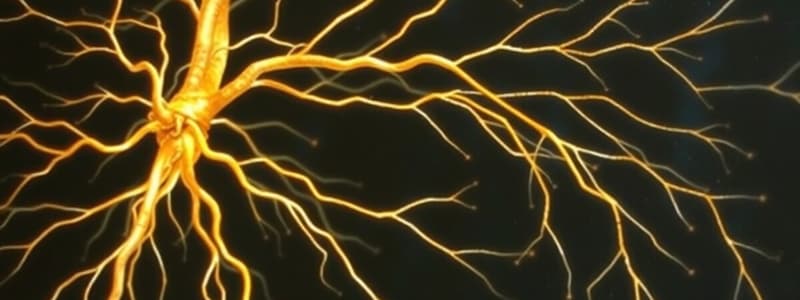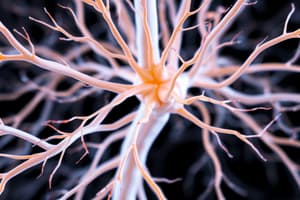Podcast
Questions and Answers
What is the primary function of the peripheral nervous system?
What is the primary function of the peripheral nervous system?
- Control involuntary muscle functions
- Process sensory information
- Produce hormones to regulate body functions
- Transmit signals between the central nervous system and the rest of the body (correct)
Which of the following correctly distinguishes between peripheral nerves and cranial nerves?
Which of the following correctly distinguishes between peripheral nerves and cranial nerves?
- Peripheral nerves are part of the central nervous system, cranial nerves are not
- Cranial nerves include both sensory and motor functions, while peripheral do not
- Peripheral nerves are exclusively motor, while cranial nerves are sensory
- Peripheral nerves originate from the spinal cord, cranial nerves do not (correct)
Which type of nerve fibers are primarily found in spinal nerves?
Which type of nerve fibers are primarily found in spinal nerves?
- Sensory, motor, and autonomic fibers
- Both sensory and motor fibers (correct)
- Only motor fibers
- Only sensory fibers
What is the main role of nerve plexuses?
What is the main role of nerve plexuses?
Which of the following statements about the dorsal rami is correct?
Which of the following statements about the dorsal rami is correct?
In terms of classification, how are peripheral sensory receptors categorized?
In terms of classification, how are peripheral sensory receptors categorized?
Which component is least likely to be a feature of the peripheral nervous system's structure?
Which component is least likely to be a feature of the peripheral nervous system's structure?
Which of the following best describes the role of ventral rami in the peripheral nervous system?
Which of the following best describes the role of ventral rami in the peripheral nervous system?
In terms of sensory receptors, which classification is often associated with temperature detection?
In terms of sensory receptors, which classification is often associated with temperature detection?
Which structure is predominantly associated with the cranial portion of the nervous system?
Which structure is predominantly associated with the cranial portion of the nervous system?
What is the primary distinction between the functions of dorsal rami compared to ventral rami?
What is the primary distinction between the functions of dorsal rami compared to ventral rami?
Which type of nerve fibers is typically present in peripheral nerves as opposed to cranial nerves?
Which type of nerve fibers is typically present in peripheral nerves as opposed to cranial nerves?
Flashcards are hidden until you start studying
Study Notes
Peripheral Nervous System (PNS)
- The part of the Nervous System that is outside the central nervous system (CNS).
- Responsible for communication between the CNS and the rest of the body.
Structure of a Nerve
- Composed of bundles of axons (nerve fibers), enclosed by connective tissue.
- Endoneurium: delicate layer of connective tissue that surrounds each individual axon.
- Perineurium: a thicker layer of connective tissue that surrounds groups of axons, forming bundles called fascicles.
- Epineurium: outermost layer of connective tissue that encloses the entire nerve.
- The endoneurium, perineurium, and epineurium all work together to protect, support, and nourish the axons within the nerve.
Two functional divisions:
- Sensory (Afferent) division
- Carries sensory input from the body to the CNS.
- Brings sensory stimuli to the CNS.
- Consists of sensory neurons.
- Motor (Efferent) division
- Carries motor commands from the CNS to the body.
- Causes muscles to contract and organs to secrete.
- Consists of motor neurons.
- Somatic nervous system (SNS)
- Controls voluntary movements of skeletal muscles.
- Has a single motor neuron extending from the CNS to the effector (muscle).
- Autonomic nervous system (ANS)
- Controls involuntary actions – heart rate, digestion, breathing
- Regulates and controls the body's internal environment.
- Has two motor neurons in the pathway – a preganglionic neuron and a postganglionic neuron.
- Somatic nervous system (SNS)
Peripheral Nerves vs.Cranial Nerves:
Peripheral
- Nerves that connect the CNS to the rest of the body
- Spinal nerves (31 pairs) emerge from the spinal cord.
- Branch out to innervate everything from the skin and muscles to the organs and glands.
Cranial
- Nerves that connect the CNS to the head, neck, and some organs.
- 12 pairs of cranial nerves originate from the brainstem.
- Each cranial nerve has a distinct function, including sensory input, motor output, or both.
Peripheral Sensory Receptors and their Classifications
- Specialized structures that detect changes in the environment.
- All classified by their origin, structure, and function.
- Exteroceptors: detect stimuli from the external environment (light, sound, touch, pain, temperature, etc.)
- Mechanoreceptors: detect mechanical stimuli such as pressure, touch, and vibration.
- Tactile corpuscles (Meissner's corpuscles): detect light touch and vibrations.
- Lamellar corpuscles (Pacinian corpuscles): detect deep pressure and vibrations.
- Bulbous corpuscles (Ruffini endings): detect sustained pressure and stretch.
- Hair follicle receptors: detect hair movement.
- Thermoreceptors: detect changes in temperature.
- Cold receptors: detect cold temperatures.
- Warm receptors: detect warm temperatures.
- Nociceptors: detect pain
- Free nerve endings: detect pain, temperature, and pressure.
- Merkel discs: detect light touch and pressure.
- Interoceptors: detect stimuli from internal environments (digestive systems, blood vessels, etc)
- Baroreceptors: detect changes in blood pressure.
- Chemoreceptors: detect changes in chemical composition of the blood.
- Stretch receptors: detect changes in the length of muscles and tendons.
- Proprioceptors: detect stimuli from within the body, such as muscle length, joint position, and body movement
- Muscle spindles: detect changes in muscle length.
- Golgi tendon organs: detect changes in muscle tension
Spinal Nerves
- Composed of dorsal (posterior) and ventral (anterior) roots
- Dorsal root: carries sensory information from the body to the CNS.
- Dorsal root ganglion: contains the cell bodies of sensory neurons.
- Ventral root: carries motor impulses from the CNS to the body.
Nerve Plexuses
Ventral Rami
- Cervical plexus: supplies the skin and muscles of the neck and shoulders.
- Brachial plexus: supplies the skin and muscles of the upper limbs.
- Lumbar plexus: supplies the skin and muscles of the lower limbs.
- Sacral plexus: supplies the skin and muscles of the lower limbs and pelvic region.
Dorsal Rami
- Innervate the skin and muscles of the posterior side of the body.
Studying That Suits You
Use AI to generate personalized quizzes and flashcards to suit your learning preferences.



